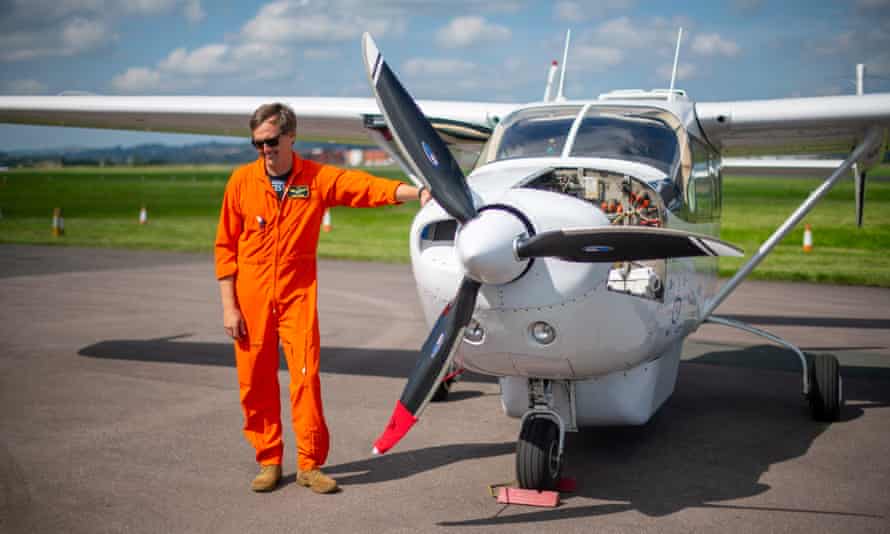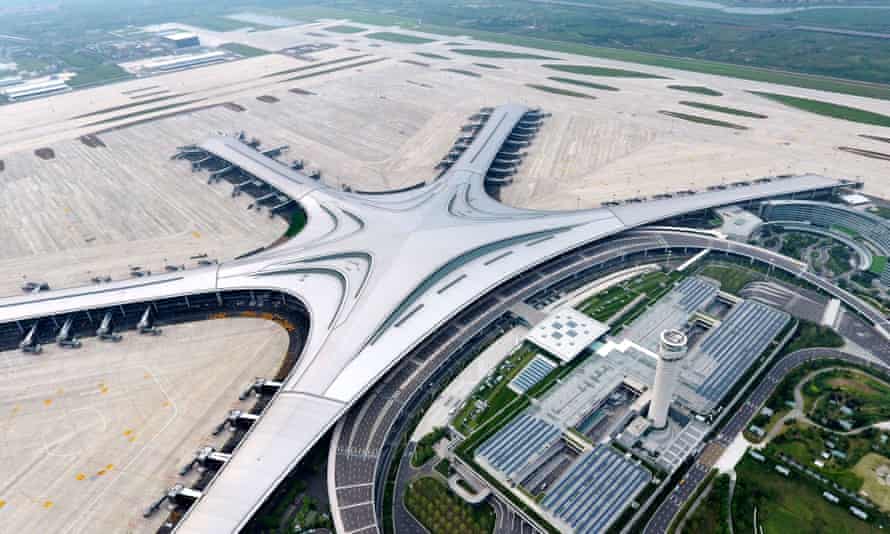Extract from The Guardian

With passenger numbers growing and time to slash emissions dwindling fast, the industry must tackle urgent stumbling blocks on fuel, frequent flyers and more.
Last modified on Mon 6 Sep 2021 05.28 AEST
Aviation tanked in 2020. The number of people taking flights fell by three quarters compared with 2019 levels and as a result there was a significant drop in greenhouse gas emissions from aviation. But as countries open up and people begin to fly again, aviation is expected to see a slow climb back to previous levels. The industry anticipates a return to 2019 passenger numbers globally by 2023 and to be back on track with previous growth projections within a couple of decades.
All this is bad news for the planet. CO2 emissions from the industry are likely to triple by 2050. But if the world is to limit global heating to 1.5C, it needs to have hit net zero CO2 emissions by this time. Aviation is a complicated sector to decarbonise. It has some prickly ingredients: difficult technological solutions, hidden extra climate effects, an association with personal freedoms and a disproportionately wealthy and powerful customer base. Here are just a few of the big hurdles the sector will need to overcome if it is ever to be carbon neutral.
1. The fuel problem
For a long time, jet kerosene from fossil fuels was the only available option for aeroplanes. “Flying through air essentially requires a lot of energy, so planes have to rely on fuels that have high energy density,” says Jagoda Egeland, an aviation policy expert at the OECD. “We haven’t had many substitutes with those kinds of properties.”
But after years of development, alternative low-carbon fuels known as sustainable aviation fuels, or SAFs, are now beginning to reach the market. These accounted for less than 0.1% of aviation fuel consumption in 2018, but the hope is that this can be ramped up over time.
In the short term, the most promising are advanced waste biofuels made from things like used cooking oils. “That is pretty cheap and has pretty good life-cycle emissions, but its supply is limited,” says Dan Rutherford, director of aviation at the International Council on Clean Transportation (ICCT). Using these fuels exclusively for aviation would provide for only about 2% of jet fuel use in the EU and US, he says.
Biofuels can also be made from crops such as palm, soya and corn. However, environmental groups have been arguing against these for years because they can compete with food production and drive deforestation – proposed EU legislation that aims to ramp up SAFs specifically excludes their use. Other kinds of “advanced biofuels” made from cellulosic plants and agricultural and forestry waste show more promise, says Rutherford.

The debut flight of the hybrid electric Cessna Sky Master, from Exeter Airport, Devon. Photograph: Jim Wileman/The Guardian
There are also completely different kinds of aircraft on the horizon. Electric planes are promising for shorter routes, and battery technology is improving all the time, says Ruth Wood, a senior lecturer in environment and climate change at Manchester University. However, the size and weight of current battery technology mean electric propulsion is still a long way off for larger aircraft, she adds.
Some companies are working on new kinds of aeroplanes designed to run on hydrogen gas, which could also be produced using clean electricity. Last year, Airbus revealed its concept for a hydrogen aircraft that it said could enter service by 2035, although it has also admitted such planes won’t be widely used until after 2050.
Chances of being solved? Clean fuels are likely to be used more and more but will make up only a few percent of fuel by 2030 and are unlikely to make a significant impact until after 2050.
2. The non-CO2 problem
Aviation accounts for about 2.5% of global CO2 emissions, but its warming impact is actually far larger owing to the other gases and particulates it emits at high altitudes. Often collectively called “non-CO2” impacts, these include nitrogen oxides and contrail clouds. These are rarely touched upon in aviation climate goals, but they could be tripling the climate impacts of aviation compared with CO2 alone.
There is still more to learn about these impacts, but policies could already be put in place to limit them, says Egeland, such as an extra charge on aeroplanes that fly at particularly bad times of the day.
It’s important to note that low-carbon fuels can still produce non-CO2 impacts, although these are expected to be lower than for kerosene for most fuels.
Chances of being solved? Unlikely in the near term given low prominence. However, the EU is beginning to pay more attention to this issue.
3. The frequent flyer problem
Some argue technological solutions will be too slow to reduce emissions in the aviation sector, and measures to reduce the amount people fly are needed to limit the damage to the climate.
But flying is not an evenly spread activity. In the UK about 15% of the population take 70% of all flights, and around half of people don’t fly at all in any given year. “That’s a pattern replicated in many other counties,” says Cait Hewitt, policy director at the Aviation Environment Federation (AEF).
The inequality in flying is even more stark at a global level. One study estimated that just 1% of the world’s population emits 50% of CO2 from commercial aviation, while just 2-4% of people fly internationally in a given year.
Some campaigners therefore support a “frequent flyer levy” as a fairer way to limit aviation emissions. The UK campaign A Free Ride argues everyone should have one annual flight free from the levy, then pay a rising charge for every extra flight taken that year. The UK’s first climate assembly also backed the idea of a frequent flyer levy.
The problem with such a levy is that many people in the frequent flyer category are likely to have the wealth to pay a moderate levy, or to have it paid by their employers, says Wood.
Manuel Grebenjak, a campaigner at the Stay Grounded network, says measures to limit flights overall, such as banning flights on certain routes, could help to stem rising emissions in a fairer way. “If a flight is banned from a certain city to another one, no one can fly, so it’s very just,” he says.
Chances of being solved? Governments, including the UK, tend to shy away from demand management approaches to limiting aviation emissions, but France and Austria are making good first steps.
4. The policy problem
All this feeds into a wider need for strong policy to tackle aviation emissions, which has largely been lacking so far. “International aviation sits outside the Paris climate agreement, because that agreement is about a country’s domestic emissions,” says Harvey. “So there was a real push to have a scheme for international aviation.”
After years of inaction, in 2016 countries at the UN aviation agency, ICAO, agreed on the Carbon Offsetting and Reduction Scheme for International Aviation (Corsia), a global deal to “offset” the growth in aviation emissions above the average levels in 2019 and 2020. However, when flights plummeted during the pandemic, countries changed the baseline of this scheme, which means there are currently no obligations on airlines. Egeland says Corsia’s effectiveness will “ultimately depend on the quality of carbon offsets that ICAO will accept”.
ICAO is also in discussions over a long-term climate goal for aviation for 2050, but it is not clear when this will be agreed or what the target will be.
Meanwhile, policies are being increasingly discussed at the national and regional level. In particular, the EU’s proposed “Fit for 55” climate legislation includes plans to mandate targets for SAFs and to end aviation’s fuel tax exemption. “Aviation fuel is exempt from any taxes almost everywhere,” says Grebenjak. “The EU wants to end the basically free rider status of aviation, and implement a kerosene tax that’s at the same level as other fuels.”
Chances of being solved? ICAO has been notoriously slow to act on aviation emissions, and many environmental groups criticise CORSIA for being far too weak, but recent policy moves at the EU level represent a significant step change.
5. The new middle class problem
Action at the EU level is encouraging, and the UK government even has a consultation out on its strategy for net zero aviation. However, the biggest growth in flying in the coming decades is expected outside Europe and the US, especially among the growing middle classes of developing countries.

Qingdao Jiaodong airport in Shandong province, China. Photograph: Xinhua/Rex/Shutterstock
Rutherford adds that frequent flyers look similar wherever in the world they are, namely upper-middle-class professionals. A global frequent flyer levy could therefore be one way to curb the growth, he says.
Chinese airlines will also increasingly have to meet local rules designed for climate mitigation if they want access to international airports, says Hewitt. But the vast majority of flights in China take place within its borders, which international policies would not apply to. “States will need to take domestic action to supplement international agreements in order to achieve net zero for aviation by 2050,” says Hewitt.
It’s worth noting that China also has the world’s largest high-speed rail network by far, while some developed countries, such as the US, have yet to install a single high-speed rail line. “We have to do our own homework first before talking about China,” says Grebenjak.
Chances of being solved? It’s up to developed countries to lead the way on reducing aviation emissions, which will then give more leeway to put pressure on developing countries.
6. The supersonic problem
Even amid growing efforts to reconcile aviation with a net zero world, some companies are pushing to develop aircraft that are even more polluting.
As well as the noise issues with supersonics, these super-fast flights could consume five to seven times as much fuel for each passenger as subsonic aircrafts. There’s also a concern that supersonics, which will be operating high in the stratosphere, will have a disproportionate impact through non-CO2 emissions, says Rutherford. Developing emissions-intensive supersonic planes could also end up being a distraction from zero emission technologies such as hydrogen planes, he adds.
Rutherford says the best way to prevent climate damage from supersonics may be to simply require them to meet the same environmental standards as other aeroplanes. “That would, in essence, act like a ban,” he says. “They just can’t meet those standards.”
Chances of being solved? Supersonics are a disaster for the climate and should be made to meet the same environmental standards as normal planes.
No comments:
Post a Comment